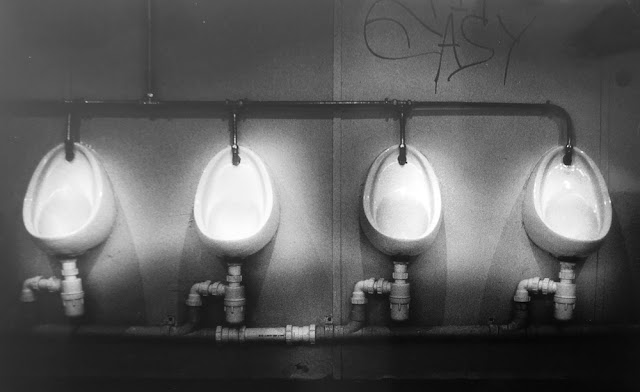Exhibition Review: Paul Walton and Andreas Athanasopoulos, China, Glasgow University
Vitreous China, the enamel that coats bathroom ceramic, is the initial connection between the work of Paul Walton, an evangelist for bio-diversity, and Andreas Athanasopoulos, a man mildly obsessed with urinals. Another factor is that they are both black and white photographers who frequent the darkroom at Street Level Photoworks. In their exhibition China they show thirty-five large glossy silver gelatin prints. The work is mixed together, but you can tell who made which prints because as Athanasopoulos says, “all of mine have urinals in, the rest are Paul’s”. Almost all of Walton’s prints feature baths discarded in fields, now encroached upon by nature.
Walton’s picture making is rooted in his attention to the age of the Anthropocene, in which human activity has become the defining characteristic of our geological epoch. His geologist father instilled in him from an early age a sense of the infinite in nature. This has been eroded gradually through his own growing understanding of human impact on the environment. As a child, the Siberian plains were for him emblematic of the vastness of nature. As an adult he feels a double sense of bereavement. Not only were the Siberian plains a nuclear testing site, it was the case even as he had formed his idyllic vision of the infinite. Indeed it was the release of radio-nuclides into the atmosphere that marked the beginning of the new geological epoch of the Anthropocene.
Walton’s outlook results in picture making strategies that re-engage people’s attention to nature. “People say we have lost touch with nature, but that’s not true. Nature is all around us, we encounter it all of the time no matter where we are, we just don’t pay enough attention to it”. Walton is not concerned with the kind of nature photography that encourages affluent people to spend vast sums of money to go see endangered species in far away places. His is a democratic eye that sees the beauty and diversity of nature in a beetle trapped momentarily in a jar, or spiders and slugs on baths in fields. It is a kind of looking and seeing that defies today’s neo-liberalising ‘eco-system services’ approach to environmentalism, where the only way to protect bio-diversity is to place a financial value on it. Walton’s work is a humble plea for a shared human ethic on how we relate to the non-human world, one where bio-diversity has value in and of itself.
Athanasopoulos is not too familiar with Marcel Duchamp, let alone Von Freytag-Loringhoven. He hails from Greece where urinals are uncommon. When he first saw them in numbers in Scotland he was struck by the visual contrast between their clean shining white surface and the darkness of walls in public toilets. He reacted to this sight in a visceral way, he thought immediately of how these “provocative” objects would look in black and white photographs. The photographs he has made show a kind of typology of urinals, some in rows some in singles, two with standing figures (both women). Athanasopoulos insists he is only interested in the urinals as objects. Yet bookending the exhibition are those two mysterious images of lone women standing in front of a row of urinals. Is one of them peeing? Is the other about to?
The urinal photographs will repel some. Humans in western society are apt to push away anything that reminds us we are animals with basic bodily functions. Such things connect us to mortality and death. The presence of women in front of this most male of symbols will also cause mixed reactions: confusion, curiosity and anxious amusement. In his own way, Athanasopoulos is a provocateur following unconsciously in the footsteps of the twentieth century’s most famous artistic chancer. Duchamp’s Fountain was lost. Its notoriety and proof of existence rely upon a photograph made by Alfred Steiglitz who said a little smugly: “The ‘Urinal’ photograph is really quite a wonder – Everyone who has seen it thinks it is beautiful – And it’s true – it is.”
On the surface of it, a serious ecologist and a cheeky provocateur make strange bedfellows. They came together through a common work ethic and work place. Nevertheless the exhibition is surprisingly coherent, the two intermingled series work well together. The stark directness of the urinals is balanced by the presence of nature in Walton’s series. The presence of insects and rain sodden foliage on abandoned bathroom ceramics plays together with Athanasopoulos’s still functioning and ordered objects to remind us we are all part of nature and if we are careless enough we will all swirl together down the drain.
All images © Paul Walton and Andreas Athanasopoulos
Note: China can be seen at the St Andrews Building (5th floor) of Glasgow University until 12th of October 2018







Comments
Post a Comment